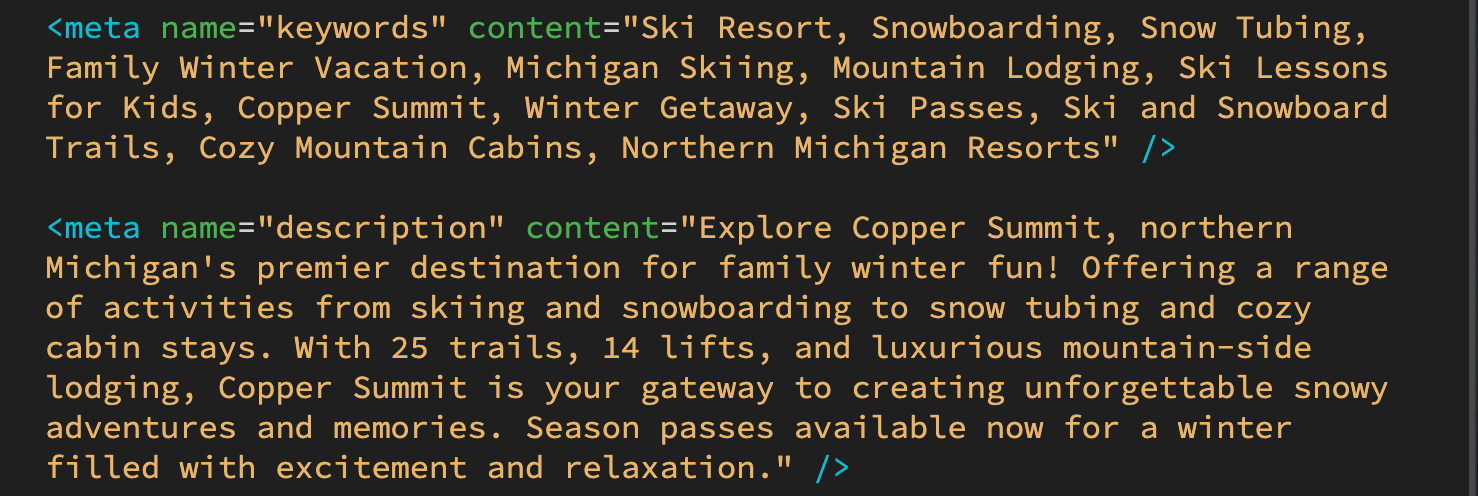Copper Summit
Designing a Responsive Website
This project involved designing and developing a responsive website for Copper Summit, a ski resort in Northern Michigan. The goal was to create an engaging, user-friendly site that showcases the resort’s offerings while ensuring seamless navigation for families. From wireframing to coding, I focused on usability, performance, and a visually appealing experience.
ROLE
UX/UI Designer & Researcher | Front-End Developer
THE PROBLEM
Copper Summit's existing online presence did not fully capture the resort’s vibrant, family-friendly atmosphere or meet modern usability standards. The website needed a redesign to improve visual appeal, enhance user experience across all devices, and better communicate the resort’s offerings to its primary audience—families seeking an accessible and memorable winter getaway.
Our Goals Were to
Improve User Engagement
Redesign the site with a focus on user experience to increase engagement through intuitive navigation, streamlined content, and interactive elements that keep users on the site longer.
Showcase Amenities and Services
Effectively highlight the resort’s amenities, such as ski slopes, lodging options, dining experiences, and additional recreational activities, through improved content organization and visual design.
Enhance Mobile Experience
Ensure the website is fully responsive so that it provides a seamless experience on smartphones and tablets, accommodating the growing number of users accessing the site from various devices.
RESEARCH
Competitive Analysis
I conducted a competitive analysis of three ski resort websites to identify key features, design strengths, and usability gaps. By examining their layouts, booking flows, and how they highlighted family-friendly offerings, I gained valuable insights into industry standards and user expectations. This research guided my design decisions, helping me create a user-centered site that stands out while addressing common pain points.
IDEATE
Mapping Out Key Features and Page Flow
I began with rough sketches to ideate the page layouts, ensuring key information was easy to find. I then translated these sketches into digital wireframes, refining the structure and hierarchy in Figma. This process allowed me to test navigation patterns and make adjustments before designing the high-fidelity screens
CODING
Building a Responsive and Optimized Site
I used Adobe Dreamweaver with HTML5, CSS3, and JavaScript to bring the design to life. I focused on improving my coding efficiency while optimizing the site’s performance.
A key challenge was ensuring responsiveness across different devices. Initially, the layout didn’t display correctly on various screen sizes, which could impact the user experience. To solve this, I studied responsive design principles, implementing media queries and flexible grid systems to create a seamless, adaptive layout.
This project reinforced the importance of mobile-first design, ensuring accessibility and a consistent experience for all users.
Enhancing Web Visibility through Strategic SEO
I implemented strategic SEO techniques across all web pages for the Copper Summit resort, focusing on crafting targeted meta tags to improve site visibility on search engines. The objective was to boost organic traffic by enhancing the site's search rankings, thereby attracting visitors looking for winter vacation options. Effective SEO is vital for increasing a site's discoverability without the need for direct advertising, showcasing my skills in both technical SEO and digital marketing strategies. This project exemplifies how SEO can significantly elevate a brand's online presence and commercial success.
FINAL DEVELOPED SITE
High Fidelity Screens
The primary screens created for the Copper Summit website include the homepage, lodging, amenities, ticket and lift passes, and the about page. These were developed first to prioritize essential user tasks and ensure a seamless experience.
MEASURING SUCCESS
To evaluate the success of the Copper Summit website after launch, I would track key performance indicators (KPIs) such as user engagement, traffic analytics, and conversion rates. Key questions include: Are visitors easily finding the information they need? How long are they staying on the site? Are they completing key actions, such as booking lift tickets or checking trail conditions?
By analyzing user behavior through tools like Google Analytics, I can assess which pages are performing well and identify areas for improvement. Additionally, feedback from users—such as ease of navigation and mobile responsiveness—will help refine the site’s functionality. Ultimately, success will be measured by an increase in online bookings, improved user satisfaction, and a seamless browsing experience across all devices.






